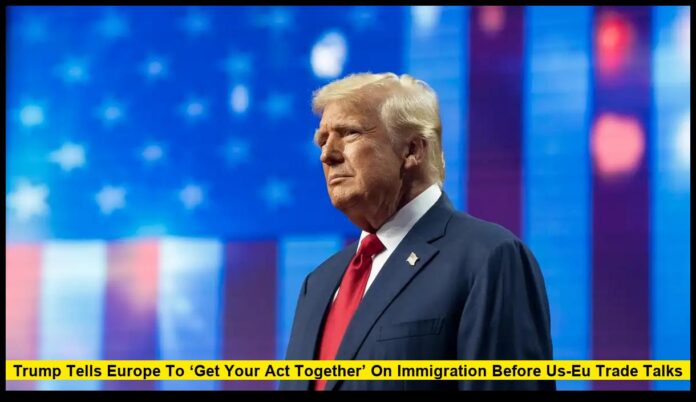President Donald Trump has delivered a stark ultimatum to European leaders during his high-stakes visit to Scotland, demanding immediate action on immigration policy before crucial US-EU trade negotiations.
Trump’s Shocking Scotland Declaration
Upon his arrival in Scotland for a five-day trip, US President Donald Trump declared that immigration is “killing Europe” and warned European leaders: “You better get your act together or you’re not going to have Europe anymore.”
The bombshell statement comes as Trump holds bilateral talks on a trade deal with the European Union that could reshape global commerce. With 30% tariffs on EU imports threatening to begin August 1, the stakes couldn’t be higher.
The Immigration Crisis That’s Dividing Nations
Trump termed immigration a “horrible invasion” and claimed that under his policies, the US had recently achieved “zero entries” at its borders. His message was crystal clear: Europe must follow America’s lead or face catastrophic consequences.
The timing of Trump’s immigration ultimatum is no coincidence. European Commission President Ursula von der Leyen will visit Scotland to negotiate terms in what could be “the biggest deal of them all” according to Trump himself.
High-Stakes Trade War Looms
The economic implications are staggering. The European Union has warned that its trade with the United States could be effectively wiped out if Washington makes good on its threat to slap a 30% tariff on goods imported from the bloc.
Trump said the prospects of securing a trade deal with the EU are at a “50-50 chance, maybe less than that” – a sobering assessment that has sent shockwaves through international markets.
Europe’s Response and Retaliatory Measures
EU member states have approved retaliatory measures if no agreement is reached, setting the stage for a potential trade war that could devastate the global economy. The pressure is mounting as negotiations continue behind closed doors.
What This Means for Global Politics
Trump’s aggressive stance represents a fundamental shift in US-European relations. By linking immigration policy to trade negotiations, the President has created a new diplomatic paradigm that forces European leaders to choose between their humanitarian principles and economic survival.
Protests have been planned, with opponents of Trump expected to gather in both Edinburgh and Aberdeen, highlighting the controversial nature of his visit and demands.
The Scotland Summit: Make or Break Moment
As of July 28, 2025, the high-stakes diplomatic drama dubbed the “Scotland Summit” has culminated in a pivotal moment for transatlantic relations. While President Donald Trump’s five-day trip to his Scottish golf resorts offered all the trappings of a personal retreat—golf games, ribbon-cutting ceremonies for a new course, and meetings with local dignitaries—the real story unfolded in the tense back-and-forth with European leaders over trade and immigration.
Trump’s arrival in Scotland—amid both supporters and hundreds of demonstrators—was marked by pointed remarks. He warned European leaders that immigration was “killing Europe,” urging them to “get your act together” or risk losing the very fabric of their societies. These remarks echo long-standing themes in Trump’s rhetoric and set the combative tone for negotiations.
The real flashpoint, however, was Trump’s ultimatum to the EU: accept new terms on trade, or face hefty 30% US tariffs on European imports starting August 1. This threat brought negotiators from both sides to the brink of a transatlantic trade war. Intense, last-minute discussions were held at Trump’s Turnberry resort and included meetings with European Commission President Ursula von der Leyen and UK Prime Minister Keir Starmer. Meanwhile, Trump’s schedule balanced business promotion with geopolitics, as he inaugurated a new golf course in Aberdeenshire.
The standoff ended just ahead of the deadline with a sweeping agreement: the US and EU will impose reciprocal 15% tariffs on the majority of traded goods—avoiding the harsher 30% rate that had loomed as a threat. As part of the deal, the EU committed to purchasing $750 billion in US energy and investing an additional $600 billion in the American economy, while both sides touted the agreement as historic, if hard-fought. Trump hailed it as “the biggest deal ever made,” though the 15% tariff rate is still expected to reshape cost structures for businesses and consumers on both sides of the Atlantic.
This outcome averts an immediate trade war but leaves in place barriers that will alter international commerce for years to come. The summit’s backdrop—Trump’s golf courses—has become inseparable from the substance of his diplomacy, symbolizing the ongoing blend of personal business interests, hardball negotiation, and the enduring volatility of US-European relations in the Trump era.
Will Europe bend to Trump’s demands, or will they stand firm and risk economic devastation? The answer could come within hours as negotiations reach their climax.
